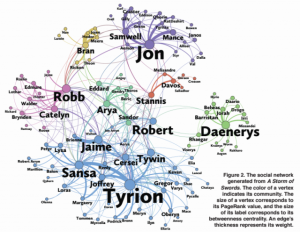Eric Geller’s piece Why ISIS is winning the online propaganda war is far too long to read but has several telling insights for jihadist wannabes.
First, perhaps without fulling realizing it, Geller points out that the appeal of ISIS is based on facts, not messages:
…
Young Muslims who feel torn between what can seem like two different worlds, who long for structure and meaning in their lives, are ISIS’s best targets. They seek a coherent picture of the world—and ISIS is ready to offer one. Imagine being 19 years old, living in a major American city, and not understanding how a terrorist attack in Paris can change the way your fellow subway passengers look at you. If that prejudice or bigotry mystified you, you might gravitate toward someone offering an explanation that felt like it fit with your experiences. You might start watching YouTube videos about the supposedly irreconcilable differences between the West and the Islamic world. ISIS shapes its content to appeal to this person and others who lack a framework for understanding world events and are willing to embrace a radical one.
The other psychological factor that ISIS exploits is the natural desire for purpose. ISIS is a bonafide regional power, and to people who already feel out of place in Western society and crave a sense of direction, joining ISIS offers that purpose, that significance. They can become part of something bigger than themselves. They can fight for a cause. ISIS’s messages don’t just offer a framework for understanding the world; they also offer the chance to help shape it. These messages “make people feel like they matter in the world,” Beutel said, by promising “a sense of honor and self-esteem, and the ability to actively live out those desires.”
There are also more pragmatic promises, tailored to people who are not only spiritually aimless but economically frustrated and emotionally unfulfilled. Liang described this part of the appeal as, “Come and you will have a real life. You will have a salary. You will have a job. You will have a wife. You will have a house.”
“This is appealing to people who have, really, no future,” she said.
…
I can see how ISIS would be appealing to:
…people who have, really, no future…
Noting that the “no future,” is a fact, not idle speculation. All Muslim youth do and will continue to face discrimination, especially in the aftermath of terrorist attacks.
The West and Islamic worlds are irreconcilable only to the extent leaders in both worlds profit from that view. Sane members of those and other traditions relish and welcome such diversity. The Islamic world has a better record of toleration of diversity that one can claim for any Western power.
Second, Geller illustrates how the focus on message is at odds with changing the reality for Muslim youth:
…
If the U.S. and its allies want to dissuade would-be jihadists from joining ISIS, they need to start from square one. “We need a compelling story that makes our story better than theirs,” Liang said. “And so far their story is trumping ours.”
The anti-extremist story can’t just be a paean to human rights and liberal democratic values. It must provide clear promises about what the Middle East will look like if ISIS is defeated. “What are we going to do if we take back the land that [ISIS] is inhabiting at the moment?” Liang said. “What government are we going to set up, and how legitimate will it be? If you look at, right now, the Iraqi state, it’s extremely corrupt, and it has to prove that it will be the better alternative.”
Part of the challenge that counter-narrative designers face is that the anti-extremist story can’t just be a sweeping theoretical message. It has to be pragmatic, full of real promises. But no one has a clear idea of how to do this. “To be totally honest, we haven’t cracked that nut yet,” the former senior administration official said. “Maybe it is liberal values and a democratic order and human rights and democratic values. I would hope that that would be the case. But I don’t think that there’s evidence yet that that would be equally compelling as a narrative or a set of values.
“Everyone agrees [that] we can’t just counter-message,” the official added. “We have to promote alternative messages. But nobody understands or agrees or has the answer in terms of what are the alternate courses of action or pathways that one could offer.”
…
How’s that for a bizarre story line? There is no effort to change the reality as experienced by Muslim youth, but they should just suck it up and not join ISIS?
One of the problems with “messaging” is the West wants dictating who will deliver the message and controlling what else they may say.
Not to mention that being discovered to be a Western lackey damages the credibility of anti-jihadists.
I’m not sure who edited Geller’s piece but there is this gem:
…
While the big-picture thinkers devise a story, others should focus on a bevy of vital changes to how counter-narratives are produced and distributed. For one thing, the content is too grim. Instead of going dark, Beutel said, go light: Offer would-be jihadists hope. Humanize ISIS’s foot soldiers instead of demonizing them, so that your intended audience understands that you care about their fate and not just taking them off the battlefield. “When you have people who are espousing incredibly hateful worldviews, the tendency is to want to demonize them—to want to shut them out [in order] to isolate them,” Beutel said. “More often than not, that actually repulses people rather than [getting] them to open up.” (emphasis added)
…
Gee, “espousing incredibly hateful worldviews,” I don’t think of ISIS first in that regard. Do you? There a list of governments and leaders that I would put way ahead of ISIS.
Maybe, just maybe, urging people to not join groups you are trying to destroy that are resisting corrupt Western toady governments just isn’t persuasive?
Have you stopped corrupting Muslim governments? Have you stopped supporting governments that oppress Muslims? Have you stopped playing favorites between Muslim factions? Have you taken any steps to promote a safe and diverse environment for Muslims in your society?
Or the overall question: Have you made a positive different in the day to day lives of Muslims? (from their point of view, not yours)
Messaging not based on having done (not promised, accomplished) those and other things, are invitations to be a Western lackey. Who wants that?
All the attribution of a high level of skill to ISIS messaging is merely a reflection of the tone-deafness of West dictated messaging. Strict hierarchical control over both messages and speakers, using messages that appeal to the sender and not the receiver, valuing message over reality, are only some of the flaws in Western anti-jihadist programs.
The old possible redeeming point is the use of former jihadists. ISIS, being composed of people, is subject to the same failings of governments/groups/movements everywhere. I’m not sure how any government could claim to be superior to ISIS in that regard.
BTW, I’m not an ISIS “cheerleader” as Geller put it. I have serious disagreement with ISIS on a number of issues, social policies and targeting being prominent ones. I do agree on the need to fight against corrupt, Western-dictated Muslim governments. Contrary to current US foreign policy.






